
The course is run by Wayne Harrison and Sacha Bowling who share the responsibilities of teaching the students to a high level on how to Film properly out on location and Edit correctly in Final Cut Pro. Wayne Harrison has been a tutor at Notting Dale Technology Centre for ten years and also teaches Desk Top Publishing (InDesign, PageMaker & Quark Xpress), Graphic Design (Illustrator & Freehand), Image Manipulation (Photoshop), Web Design (Flash & Dreamweaver), CD ROM Presentations (Director), DVD Presentations (DVD Studio Pro), 3D modeling (Infini-D), Film Editing (Final Cut Pro & Premiere), Special Effects for film and video (After Effects, Motion & Combustion) and soon in the near future he will be doing a sound course in (Pro Tools LE).
Sacha Bowling has been in the film business for 19 years and started of his trade in West London. He then decided to take a chance by going to Los Angles (Hollywood) to find work in the film business. After being turn down by many people he got his lucky break working as a runner on a film set. As time went on he quickly moved up the ranks to become a key grip. He has worked on films such as Independence Day, Stargate and True Lies. Eventually after 5 years in Los Angles, Sacha Bowling decided to come back home and start up a Production Company, but shortly after had a child so had to close the business due to family commitments. Sacha Bowling then decided to do a course in Advance Multimedia at Notting Dale Technology Centre with Wayne Harrison and they became good friends and started making short movies together with Notting Dale students. He is currently a tutor at Notting Dale Technology Centre and he is also a 1st Assistant Director on Commercials and Pop Promo's.
| Here are some photo's of Wayne Harrison & Sacha Bowling filming with students: |
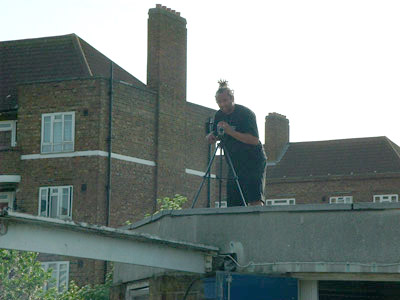 |
Sacha Bowling is the camera operator and is filming on the roof at the Fatima Centre. The camera department is made up of the DP (director of photography), camera operator, 1st Assistant, 2nd Assistant and a loader. The first camera assistant (1st AC) is responsible for keeping the camera in focus, making lens changes, threading the film, and maintaining the camera. The 1st AC never leaves the camera's side. The 2nd AC and loader aid the 1st AC. (White City). Summer 2002 |
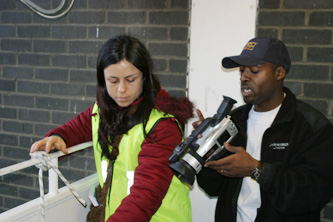 |
Wayne Harrison is showing Nadia Petean how to hold the camcorder properly and is checking that she doesn't have the auto focus on. Auto Focus should be avoided particularly when shooting scenes with little contrast (sky, walls, ocean, snow), scenes with very low light levels. Automatic anything is bad. Use manual focus as often as possible! (Frinstead House Tower Block, Freston Road), Spring 2004 |
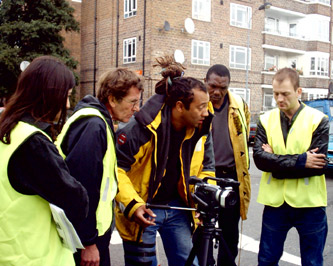 |
Sacha Bowling is showing the film crew how to set-up the camcorder for the next shot. Film making is 90% planning, and often fairly mundane planning at that. You have to check parking restrictions, make sure there are mains sockets where you need them, ensuring that nobody has booked the decorators to come in on the same day as you'll be shooting. Your client won't think of these things, so you'll have to! (White City). Autumn 2003 |
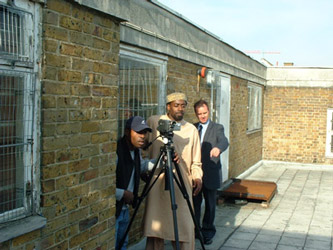 |
Wayne Harrison is the director and he is checking that Martin Charles has the right exposure, framing, focus and sound levels before he begins recording. As light enters the camcorder's lens it is focused on by a light-sensitive computer chip called a Charge Coupled Device (CCD). The surface of the CCD is composed of thousands, if not millions, of microscopic silicon particles that act as tiny meters, each generating an electrical charge proportional to the light striking it. Most of the smaller and cheaper camcorder's use one CCD to gather picture information. Higher-end camcorder's use 3. Each CCD handles one of the three Primary colours: Red, Green and Blue. (White City). Summer 2002 |
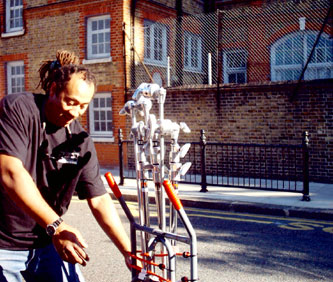 |
Sacha Bowling is putting some Century Stands onto the minibus. We constantly need to hang lights in awkward places, so naturally, over the years, a myriad of stands, clamps, arms and suspension rigs have been devised to secure a lantern or flag almost anywhere. Stands come in two basic types, baby stand and junior stand (combo stand). Stands of both types come in short, 'low boy' versions as well as the standard height with two-sections or three -sections. Stands may be made of aluminium, which is lightweight, or of steel, which can bare more weight. The actual type of light you use isn't nearly as important as how you control it. (Freston Road). Autumn 2003 |
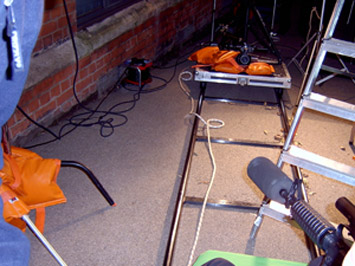 |
The camcorder has been securely mounted onto the dolly, supported by a tripod, one magic arm and two sand bags. The nature of the action, and the way it is going to be shot, will influence how much equipment you need. If two people sit close together they can share the lighting. Put further apart, they will have to be lit separately. (Freston Road). Spring 2004 |
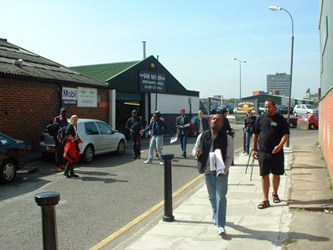 |
Wayne Harrison has the storyboard in his hands and is showing Sacha Bowling how he wants the action to be. When a movie is made from a script, the filmmaker has the possibility of preplanning the shots. Some directors simply do a rough breakdown of scenes in terms of camera coverage: a wide shot here, matching close-up there. Some prefer to storyboard sequences by drawing a picture of each shot. Storyboard's can be drawn by hand or by using software like Storyboard Quick. (Bard Road). Summer 2002 |
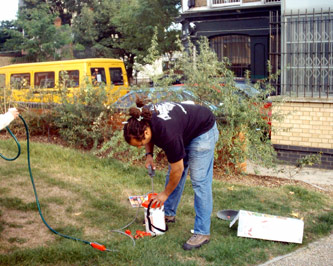 |
Sacha Bowling is using the Pump Compressor filled with fake blood, so the soldier can look as thou he has been shot with lots of fake blood flying out of his body. If you want to know more about how to make fake blood and bullet hits checkout (Guide to Film-Making). (Freston Road). Autumn 2003. |
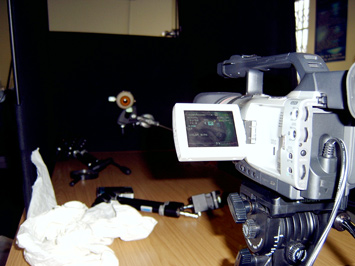 |
The Canon XM2 is ready to start filming the dummy eye which is mounted onto a century stand for a movie called "The Agent" which is written, produced and directed by Wayne Harrison & Sacha Bowling. The reason we had to use a dummy eye is because it is very dangerous to point a laser beam into someone's iris, so the only alternative is to get a dummy one instead, (Notting Dale Technology Centre, Room 1). Spring 2004 |
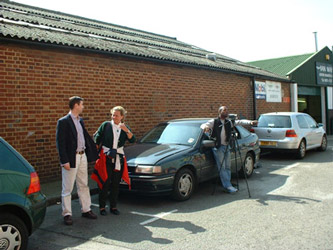 |
Wayne Harrison is the Director on the film set and is giving the students instructions on how he want's the action to be. Both in fiction and documentary work, maintaining a comfortable, professional atmosphere is extremely important. Avoid shouting and arguments in front of the actors or documentary subjects and do not involve them unnecessarily in your technical business and problems. Actors and subjects should be treated with a great deal of respect! (Bard Road). Summer 2002 |
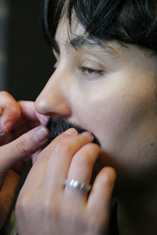 |
Today, make-up and hair are still one department, and their skills include working with wigs and facial hair. As hairdressing takes longer to learn and become proficient at, it is helpful if hairdressing are developed first. On small productions it may be that the make-up artist will not know who the artist are until arriving on location. That means that he/she has to be prepared for most situations. This entails carrying a lot of equipment and materials, especially make-up. As cinema demands top quality pictures, more time and money are available for make-up and hairdressing, and the departments are separate. The hairdresser has to undertake extra training to be able to work with wigs, although any facial hair is dealt with by the make-up department. (Frinstead House Tower Block, Freston Road), Spring 2004 |
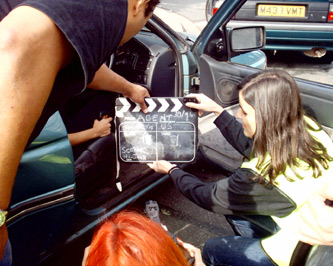 |
Sacha Bowling is helping Yolanda Garcia position the clapperboard correctly for the camera. The clapperboard is usually handled by an assistant who writes and reads aloud the scene and take numbers and/or the sound take number before snapping down the hinged part of the slate at the beginning of each take. (White City). Autumn 2003 |
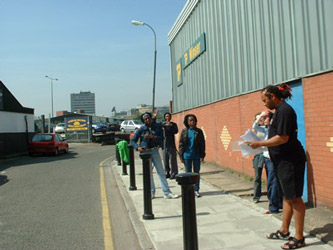 |
Sacha Bowling is the assistant director and he is looking at the storyboard's. The assistant director (1st AD) runs the set. He or she co-ordinates the actions of every department and the cast, plans the day's schedule, approves the call sheet (which is usually prepared by the second assistant director), keeps everyone informed about the shot, plans ahead to minimise the amount of time used for each set-up, makes sure the needed actors and crew are present and controls extras in crowd scenes. (Bard Road). Summer 2002 |
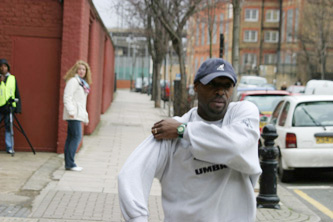 |
Wayne Harrison is giving Jenny Grogan (second unit director) and students some instructions on how to set up the camcorder for the next shot. A film crew is composed of freelance artists, technicians, and administrators who are brought together by the production company when the production is ready to be mounted. The producer and director select the department heads: the DP, production designer, sound mixer, editor and so on. Each department head usually brings his or her own staff on to the production. The DP recommend a gaffer, camera grip, camera operator and camera assistant with whom he or she prefers to work with. The gaffer, in turn, recommends electricians he or she knows and trusts. (Freston Road). Spring 2004 |
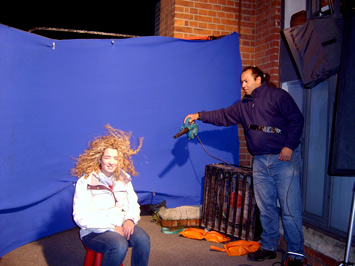 |
Sacha Bowling is testing out the air blower on Jenny Grogan. Wherever you're shooting, plan for everything you can and leave room for the inevitable surprise. While on location, never count on the weather. Crews have been stranded for weeks waiting for snow, sun or whatever else. Be ready to shoot interiors when the weather is not right, and have a backup schedule for when an actor gets sick or some special equipment does not operate. Duplicate wardrobes and props allow the production to continue even when a prop has been misplaced or a shirt has gotten dirty. Backup locations allow you to continue if plans fall through. (Freston Road). Spring 2004 |
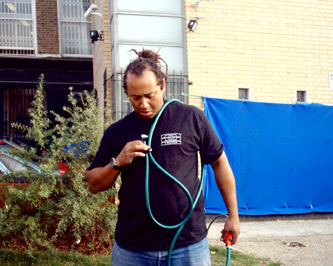 |
Sacha Bowling is showing the students how he will fit the hose around the actors body before he pumps up the compressor with air. (Freston Road). Autumn 2003 |
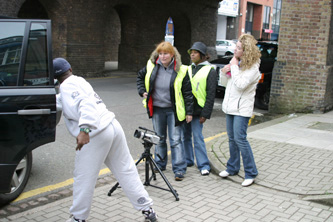 |
Wayne Harrison is explaining to the students and Jenny Grogan (second unit director) how the action will be so they can frame up and position the camcorder for the next shot. The standard procedure for filming each new scene has four steps: block, light, rehearse and shoot. First the director, DP and actors block the entire scene (plan the staging). During blocking rehearsal, the set is usually cleared so that the actors and director can work without distraction. The director and principal actors are called the first team. The DP, gaffer and key grip watch the rehearsal to determine lighting needs and constraints. Once the scene has been blocked, the actors are sent to make-up, and the DP begins lighting the set. (Freston Road). Spring 2004 |
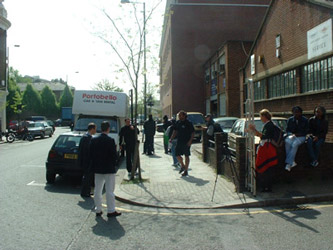 |
The Notting Dale film crew are getting ready to set-up the film equipment. As times have changed and companies have had to review their financial commitments, the workforce has now become predominantly freelance. This means nothing can be taken for granted. Freelance work offers all the benefits of self-employment, if you are the type of person who sees them as benefits! It requires good business management skills in organising tax and insurance, purchasing equipment and, of course, getting work. There are many people who prefer to stay in employment or contract work if they can because, in spite of it's limitations, it offers security, peace of mind and the sense of belonging. (Freston Road). Summer 2002 |
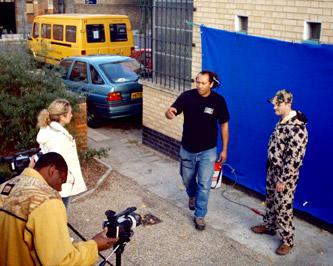 |
Sacha Bowling is the director and is giving the actor instructions. After you develop a rhythm with your actors you'll find that the first take's almost always the one with the magic. Generally you'd shoot a couple more takes, then come around for the close-up or the two-shot and do the series all over again. But chances are, you're not using top-notch actors. When you are filming, rehearse as much as possible, block the scene for the camera operator so he knows what is going to happen and when. If the scene could be spontaneous in terms of performance from the actor, allow the camera operator to widen the lens so there is more space in frame to accommodate the unexpected. This will avoid losing the frame or focus, forcing a retake which will probably be wider anyway. (Freston Road). Autumn 2003 |
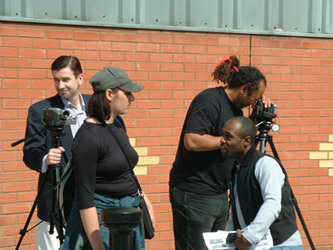 |
Wayne Harrison is having a talk with Monica White who is the Art Director for the day. On big productions, the ability to be part of a team will be a necessity. Work starts early in the morning and a 12-hour day is usually considered a short day. The people around you will be your friends and work colleagues constantly for the next few months. (Bard Road). Summer 2002 |
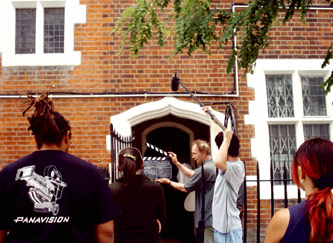 |
Sacha Bowling is the assistant director and is making sure the crew do the job properly on a movie called "Blind Date" written by Kary Stewart (Freston Road). Summer 2003 |
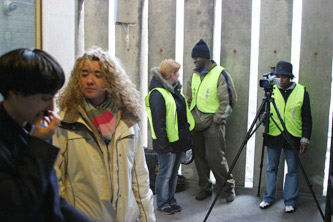 |
Jenny Grogan is the make-up artist and is making sure Kimberly Robinson has her moustache on properly. There should be someone from each department standing by on set. If it is a large production, the make-up, hair and costume staff usually have certain artists to look after, and it is not uncommon for everyone to be on set. This is mainly for continuity reasons, especially for films, when each scene is broken down into a series of sequences. It is important to know whether the coat was open or closed, or whether the hair was behind the ears or not. This would usually be the job of the script supervisor who is responsible for continuity and making sure that shots match in everything from weather to hairdo and that everything has been shot from the angles called for in the script. (Frinstead House Tower Block, Freston Road), Spring 2004 |
 |
The dummy eye has been surrounded by flags to reduce lens flare from the light coming through the windows. (Notting Dale Technology Centre, Room 1). Spring 2004 |
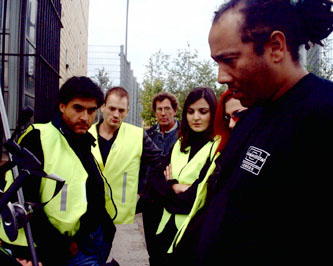 |
Sacha Bowling is showing the students how to rig a camcorder safely onto the side of a car. Getting work in the film business can be an extremely daunting prospect. You need to be resilient and not too fazed by rejection. There are many people trying to get work in this field and courage and perseverance are necessary. The first thing is to get the best training you can find. Time spent as a 'runner' with a film or TV production would be extremely useful. A runner is someone who does any little job necessary, mainly for the production team, but also for other departments. This work is extremely badly paid, if paid at all, but does give people the opportunity to experience this kind of work and the commitment required for it. You will need a CV, or curriculum vitae, and you will also need to build up a portfolio of your work. College work will be a start! (Freston Road). Autumn 2003 |
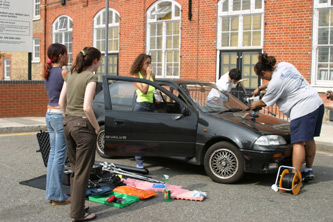 |
Sacha Bowling is setting up the camcorder onto the front of the car with a suction cup. (Freston Road). Summer 2003 |
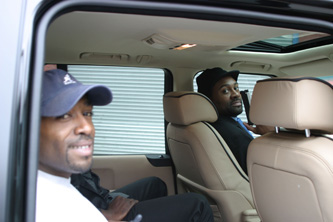 |
Wayne Harrison and Brian Bellot are doing some acting and are waiting in the Range Rover for instructions from Sacha Bowling who is the Director. Many actors and actresses prefer contact with fewer people. Increasingly, smaller film productions are now working in this way. (Freston Road). Spring 2004 |
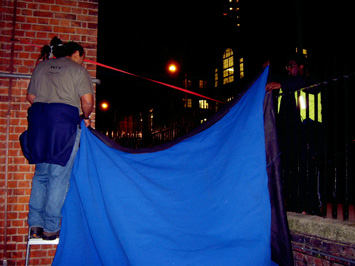 |
Sacha Bowling is putting up the blue screen with the help of student Andre Moses. (Freston Road). Spring 2004 |
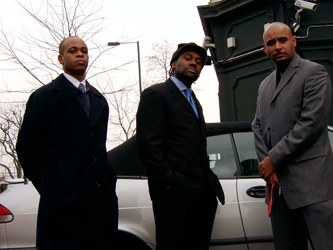 |
Sean Lawson, Brian Bellot and Delroy Beaton are acting as bodyguards in a movie called "The Agent" which is written, produced and directed by Wayne Harrison & Sacha Bowling. (Freston Road), Spring 2004 |
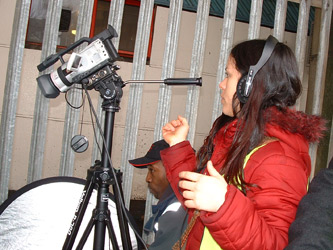 |
Nadia Petean is on the camcorder, Wayne Harrison is the Gaffer and is using the reflector to bounce the light coming from the sun onto the subject, this is because the location was too dark and you couldn't see the subject very well. (Cambridge Gardens), Spring 2004 |
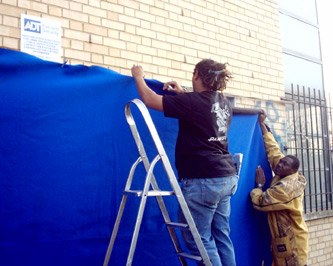 |
Sacha Bowling is putting up the blue screen with the help of student James Masangomai. (Freston Road). Autumn 2003 |
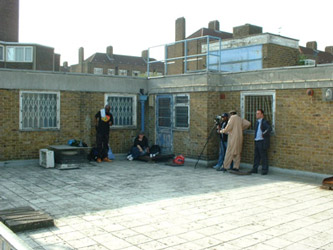 |
The
Notting Dale film crew have set-up the film equipment and are ready for
the action to begin. All things being equal you should figure on an efficient
production crew getting at least thirty to forty exterior set-ups a day. Interiors generally slow you down a bit because of the lighting. If they don't slow you down then you're not taking enough time lighting the scene. (White City). Summer 2002 |
 |
Here is a closer view of the eye which is mounted onto the century stand and is supported by a magic arm claw. The eye was borrowed to us by Kate McConnell who is the manager at a Special Effects and models company called ASYLUM, based in Earlsfield. Sometimes its not only what you know, but who you know! |
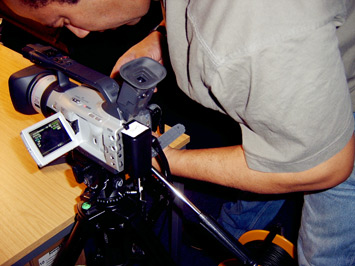 |
Sacha Bowling is setting the exposure on the camcorder before he starts filming. It's usually easier to shoot while looking at the flip-out LCD monitor than into the viewfinder except in very bright sunlight. If you use the LCD monitor whilst filming, it will use more battery power than if you had used the viewfinder. The lithium batteries can be recharged at any time without developing memory effects, and are light weight. (Notting Dale Technology Centre, Room 1). Spring 2004 |
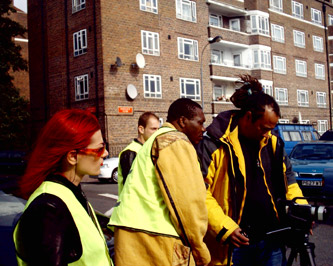 |
Sacha Bowling is framing up the next shot by zooming in and out until he is happy with the visual composition. The zoom is there primarily to provide a range of focal lengths allowing different shot sizes. Don't use the zoom. Not while filming, anyway. It's there to save you from walking back and forth, or physically switching between lenses. If you want to move from an establishing wide shot to a close up, try to set both up as separate shots rather than zoom between them. It can be used to good effect, but the mere fact that you can remember zoom effects in movies mean it's an obtrusive trick which should be used sparingly. (White City). Autumn 2003 |
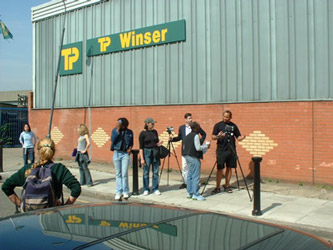 |
Wayne Harrison is the director and producer. He is discussing with Sacha Bowling how he wants to film the next shot. The producer raises the money for a production and often creates the "package" which may include the script, the director and the actors. The producer is ultimately responsible for the budget and the overall production and can usually hire and fire personnel. The director is responsible for the production unit, translating the script into visual terms and directing the actors. In television production, the producer is often more like the film director. (Bard Road). Summer 2002 |
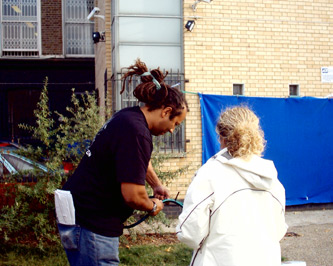 |
Sacha Bowling and Jenny Grogan are fixing the pump compressor. (Freston Road). Autumn 2003 |
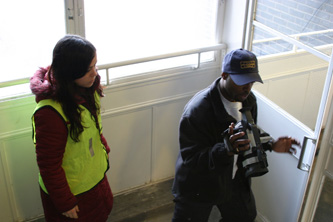 |
Wayne Harrison is showing Nadia Petean where he wants her to be with the camcorder. (Frinstead House Tower Block, Freston Road), Spring 2004 |
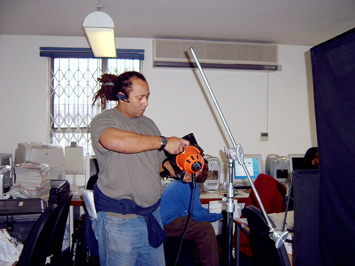 |
Sacha Bowling is setting up an 800 watt red head studio light in the classroom. Working in the classroom can decrease your work time and reduce your overheads. You won't have to rent offices and you can start work the moment you arrive. If you intend to shoot a movie from home, rent a very big house, and I mean BIG! Preferably in the country where you can't disturb neighbours. A call to the police from an angry neighbour could shut down production and force you to relocate. (Notting Dale Technology Centre, Room 1). Spring 2004 |
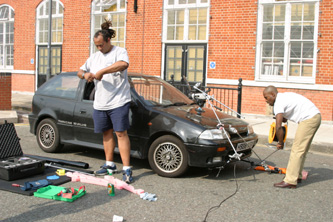 |
Sacha Bowling and Wayne Harrison are rigging the camcorder onto the car. (Freston Road). Summer 2003 |
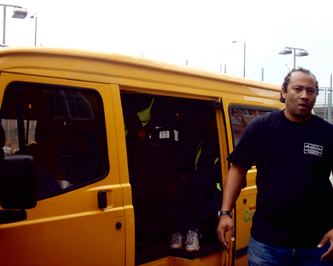 |
Sacha Bowling is making sure that everybody is on the minibus so Wayne Harrison can drive them to the location. (Freston Road). Autumn 2003 |
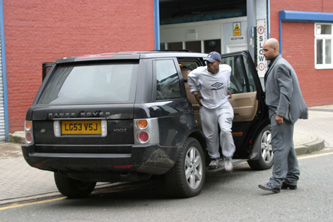 |
Wayne Harrison is acting as the big boss and Delroy Beaton is acting as his bodyguard. It is important to be aware that artist can be easily distracted by people talking and moving, or even just standing in their eye line. It is necessary to be sensitive to any behaviour that may distract others. (Freston Road). Spring 2004 |
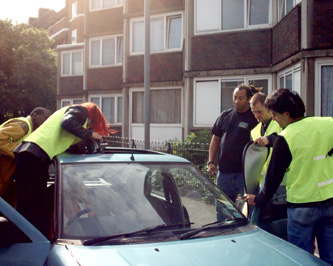 |
The video production crew are filming a scene for a movie called "The Agent" assisted by Sacha Bowling. (White City). Autumn 2003 |
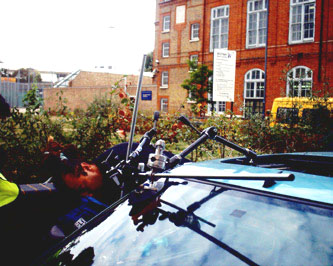 |
Sacha Bowling is making sure the actor is alright in the car. (Freston Road). Autumn 2003 |
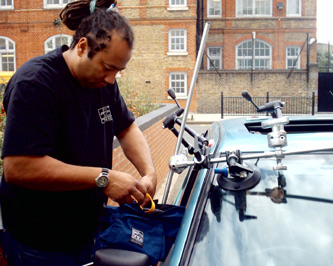 |
Sacha Bowling is putting the rain cover over the camcorder to protect it just incase it starts to rain. After it rains, don't forget to dry the covers out. Mildew is not a pleasant odour. (Freston Road). Autumn 2003 |
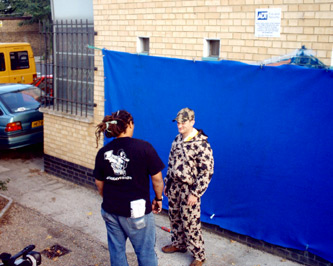 |
Sacha Bowling is giving Scott Lee Sellers who is acting as a soldier instructions. When costume is needed try and keep a tight reign on your designer, don't let them go over budget. Actors can be persuaded to use their own clothes, but beware of damages. Charity shops are a great source. If you can return the items, you could negotiate a good deal. (Freston Road). Autumn 2003 |
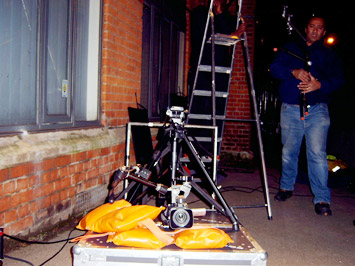 |
Sacha Bowling is rigging the camcorder onto the dolly for safety. As with employment everywhere, safety for you and others is paramount. There are strict safety precautions and rules that apply in any studio; for example, no smoking, no consumption of food or drink in the studio. (Freston Road). Spring 2004 |
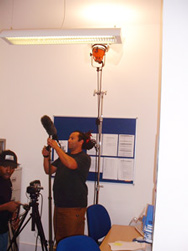 |
Sacha Bowling is setting up the Boom Mic and Wayne Harrison is setting up the camcorder. The camera department is made up of the DP, camera operator, 1st Assistant, 2nd Assistant and a loader. They are responsible for keeping the camcorder in focus, making lens changes, threading the film, and maintaining the camcorder. (Notting Dale Office). Winter 2003 |
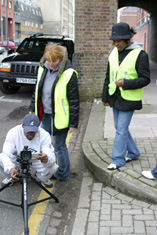 |
Wayne Harrison is showing the students how to set-up the camcorder properly onto the tripod and make sure that it is level. The tripod is a three-legged camcorder support. The camcorder mounts on the tripod head, which sits on the tripod's legs. Heads designed for motion picture work are able to pan (short for panorama), which is to rotate the camcorder horizontally, or to tilt, which is a vertical rotation. Whenever possible, plan and rehearse pans and tilts. Adjust the tripod so the front leg points in the direction of the lens to maximise the amount of room behind the camcorder. (Freston Road). Spring 2004 |
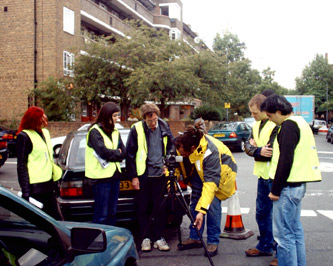 |
Sacha Bowling is showing the students how to set-up the tripod correctly early in the morning. Steadily and continuously the sun sweeps across the sky all day long. Shots you took in the morning sun won't always cut into shots at the same location later in the day. (White City). Autumn 2003 |
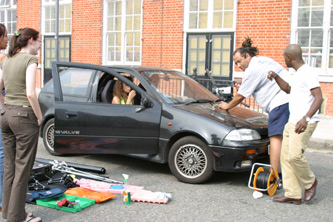 |
Wayne Harrison is with Sacha Bowling discussing what equipment is needed to rig-up the camcorder to the car safely. (Freston Road). Summer 2003 |
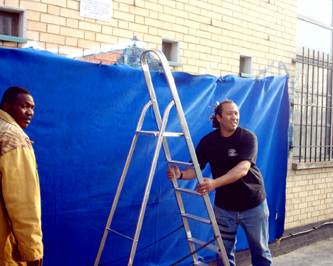 |
Sacha Bowling is moving the ladder to set up the blue screen with student James Masangomai. (Freston Road). Autumn 2003 |
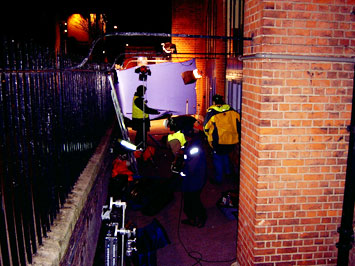 |
Sacha Bowling and Wayne Harrison are setting up the lights with the assistance of the students. Some filmmakers make their movies alone, which is especially feasible when using a small-format video camcorder. A typical small crew for a documentary may consist of a cameraman and a sound recordist, with either or both functioning as director. A third person may be needed to manage equipment, drive the car, help set up lights and run errands. (Freston Road). Spring 2004 |
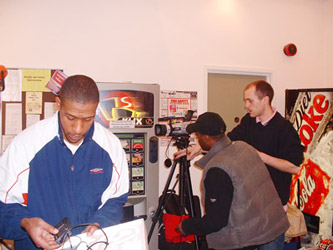 |
Wayne Harrison is making sure the camcorder is set up properly with a student called James Shears. Kieron Shaw is setting up the sound equipment. During production, every time the camcorder is moved to a new spot to get a different scene or camera angle, this is considered a new setup. The daily production report on a feature tracks how many set-ups were filmed that day. Changing set-ups often implies not only changing camera position, but lighting and other aspects as well. (Notting Dale Reception Area). Winter 2003 |
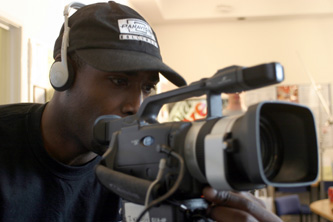 |
Wayne Harrison has positioned the camcorder low to the ground. Just because you see life at eye level, don't confine the camcorder there. This is not life, it's art. The placement of the camcorder is one of the most important acts in filmmaking. It is the statement of what the scene represents and how the audience is supposed to view this particular situation. (Notting Dale Reception Area). Summer 2003 |
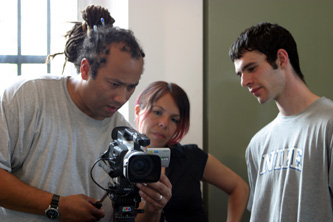 |
Sacha Bowling is checking the framing with students on the LCD (Liquid Crystal Display) monitor before he starts filming a movie called "The Agent". Each shot is composed or framed in the camcorders viewfinder or LCD monitor. When you film from a script, each shot is blocked out, or planned, before the take. In unscripted work such as documentary, framing and movement are improvised based on both what is seen through the viewfinder or LCD monitor and what is seen and heard outside the frame, (Notting Dale Reception Area). Summer 2003 |
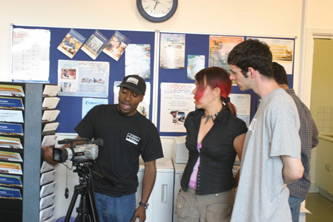 |
Wayne Harrison is explaining how to use the camcorder with the students. One of the most important functions on the camcorder is the 'shutter'. Unlike a film camera, this is not a moving mechanical part. The video shutter works by reducing the amount of time the CCD (Charge Coupled Device) collects light for each field. Bear in mind that using a higher shutter speed does not mean the camcorder records more frames each second. A PAL (Phase Alternating Line) standard camcorder still records 25 frames a second and NTSC (National Television Standards Committee) camcorder records 29.97 frames a second, but each frame is exposed to light for less time. (Notting Dale Reception Area). Summer 2003 |
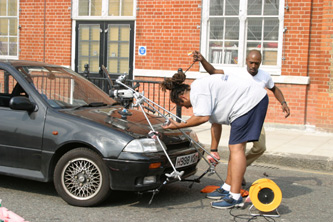 |
Wayne Harrison and Sacha Bowling are working hard setting up the camcorder rig for the next shot. (Freston Road). Summer 2003 |
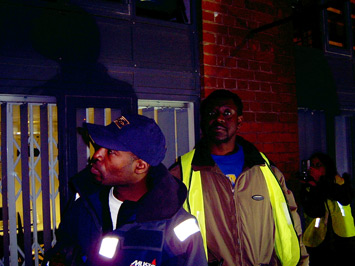 |
Wayne Harrison is setting up the lights with the help of student Patrick Quarshie. The camcorder's image sensor (pickup device) needs a certain amount of light from all parts of the scene, to produce an image with a wide tonal range. If there is too little light around, the picture will be under exposed and shadow details will be lost. Underexposure may also cause distracting visual defects. You may compensate by opening up the lens aperture to a (larger f/stop; smaller number), but this will limit the depth of field. Exposure is the calculation of light intensity over time and the aperture controls the amount of light allowed to pass through a lens. (Freston Road). Spring 2004 |
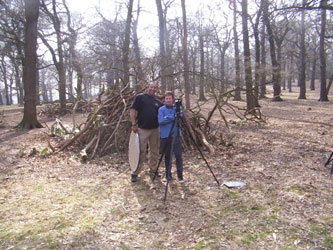 |
Sacha Bowling and Ian Davies are posing for the camera whilst they are waiting for the actors and make-up artist to arrive onto the film set. Every second counts in the making of a short movie, especially for live television and feature films. Every member of the cast and crew is responsible for good timekeeping. One member being a few minutes late can affect the whole crew. This is especially important for make-up, hair and costume departments as they often start work before other departments. (Richmond Park). Spring 2003 |
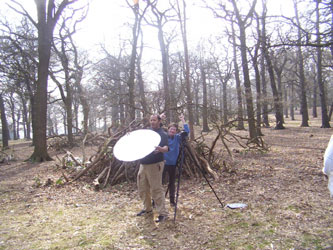 |
Sacha Bowling is the gaffer and is holding the reflector. The gaffer is the head of the electric department, and is in charge of the lighting crew. The gaffer's crew consists of the assistant chief lighting technician, known as the best boy electric or second electrician. Under the best boy are the set electricians, also known as sparkies. (Richmond Park). Spring 2003 |
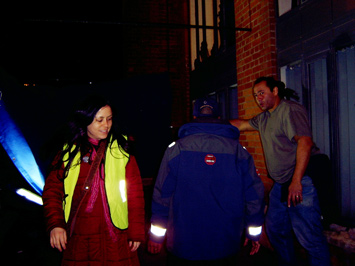 |
Wayne Harrison and Sacha Bowling are discussing how they are going to set up the scenery for a blue and green screen shot in the dark. Filming in very poor lighting conditions such as nighttime which has just a little amount of light available can be tricky. In this scenario, you would use the gain switch that increases the camcorders sensitivity in low-light situations. When you increase the gain, you add noise to the image, which in some instances look a bit like the grain found in a fast film emulsion. Many people use the gain setting as a shortcut to lighting. Never use gain! What you loose by boosting gain in the acquisition stage is resolution, colour space and the ability to control the amount of grain you end up with in your final print. (Freston Road). Spring 2004 |
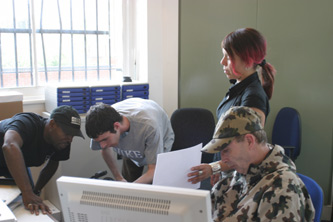 |
Wayne Harrison is checking the white balance with students. Unlike the human eye, the CCD is stupid. It translates what it is fed into electrical current which is encoded into a video signal. Video has an entirely different method for dealing with colour temperature. It is called "white balance" and it's basically a modulator that shifts the frequency of the entire video signal up or down to accommodate for the ambient colour of the environment. (Notting Dale Reception Area). Summer 2003 |
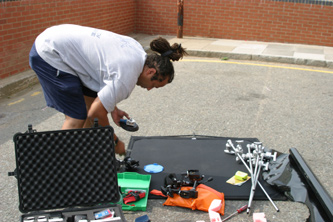 |
Sacha Bowling has all the required equipment that he will need to rig the camcorder safely onto the car. (Freston Road). Summer 2003 |
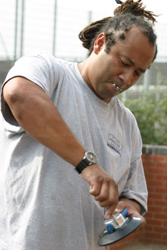 |
Sacha Bowling is fixing the Suction Cup to mount the camcorder onto it. (Freston Road). Summer 2003 |
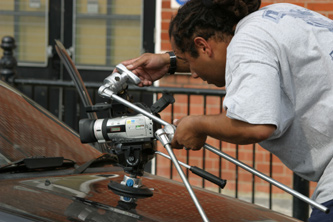 |
Sacha Bowling has the camcorder positioned on the front of the car which is being supported by the Suction Cup. He is now starting to position some arms and knuckles from a Century Stand to secure the camcorder from falling. (Freston Road). Summer 2003 |
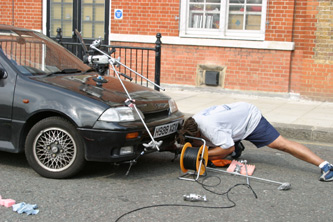 |
Sacha Bowling is using the Magic Arm which is positioned underneath the bumper to hold the bottom of the Century Stand Arm in place so it doesn't become loose. (Freston Road). Summer 2003 |
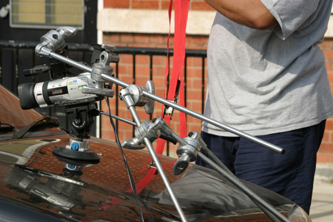 |
Sacha Bowling is preparing to use the Ratchet Strap to secure the rig even further. (Freston Road). Summer 2003 |
 |
Sacha Bowling is making sure the camcorder is properly secure. (Freston Road). Summer 2003 |
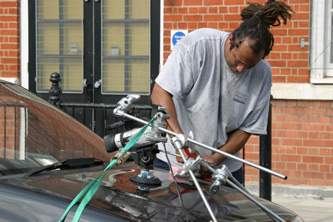 |
Sacha Bowling is using foam underneath the Ratchet Strap so that it doesn't scratch or mark the paint on the car. (Freston Road). Summer 2003 |
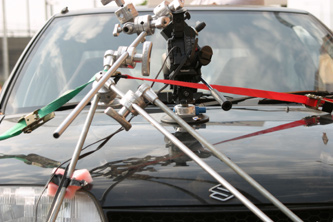 |
This is a front view of the camcorder being securely rigged onto the front of the car. (Freston Road). Summer 2003 |
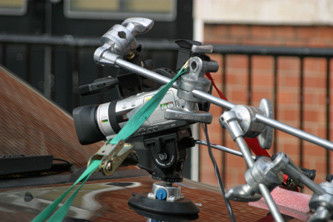 |
This is a close up view of the camcorder being securely rigged onto the car. (Freston Road). Summer 2003 |
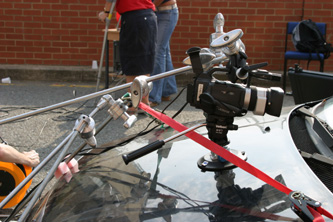 |
This is a side view of the camcorder being securely rigged onto the front of the car. (Freston Road). Summer 2003 |
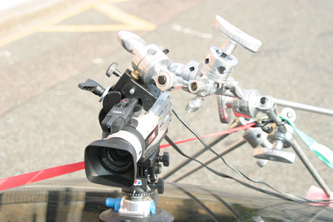 |
This is a top view of the camcorder rig. A magic arm claw has been used to hold the camcorder firmly into position so it doesn't start shaking around when the car is moving. (Freston Road). Summer 2003 |
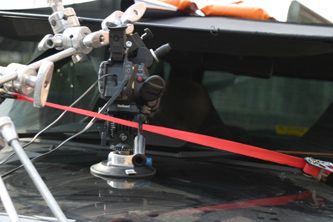 |
A black flag has been positioned on the top of the car to block out the sunlight and reflections. Another option we could have chosen is to put a polarizing filter onto the lens which can progressively eliminate the reflection from the glass or just drive on a road such as Holland Park Avenue, that has a lot of trees covering it from above to block out the light. (Freston Road). Summer 2003 |
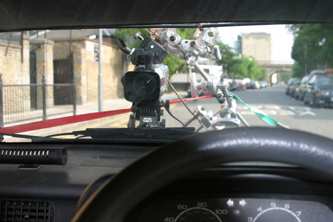 |
This is what the actors will see when they sit inside the car. Sometimes if an actor has a lot of lines to read, it is much safer if you have another car for towing the main car because the actors can concentrate more on their lines rather than worrying about crashing the car and damaging equipment. (Freston Road). Summer 2003 |
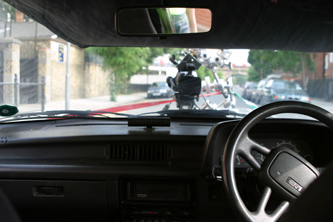 |
This is what it looks like inside the car when you are sitting on the back seat. (Freston Road). Summer 2003 |
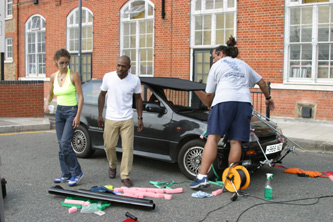 |
Wayne Harrison and Sacha Bowling are showing the students how to rig the camcorder safely onto the car. (Freston Road). Summer 2003 |
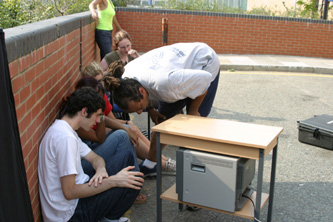 |
Sacha Bowling is checking the broadcast monitor to make sure everything looks good whilst the crew are waiting. This is why it is important to have a friendly crew to relieve the stress of production-making. (Freston Road). Summer 2003 |
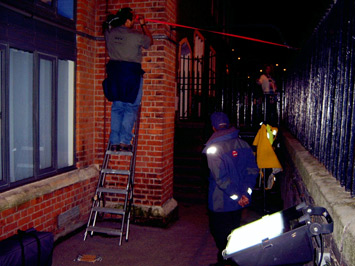 |
Wayne Harrison is watching Sacha Bowling set up the ratchet strap so the blue screen can be attached onto it with crocodile clips to clamp it down. (Freston Road). Spring 2004 |
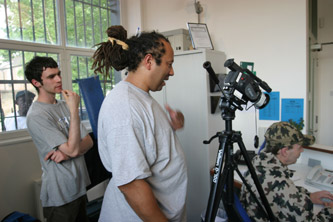 |
Sacha Bowling is setting up the next shot with students, The final stage of planning your shoot is deciding all the shots and sequences you're going to need. For controlled situations, where you can direct the action and the camcorder, nothing beats a proper storyboard made up of small drawings detailing each shot and action. If that's not feasible, at least make sure you produce a full shot list in shooting order. (Notting Dale Reception Area). Summer 2003 |
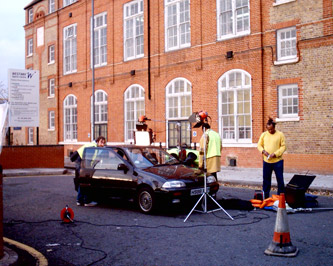 |
Sacha Bowling is setting up lights before filming to make the inside of the car appear brighter. This is because the interior of the car was very dark and you couldn't see the actors face, (Freston Road). Winter 2003 |
 |
Wayne Harrison is letting Nadia Petean and Andre Moses set up the shot. In Great Britain, Western Europe, Australia, New Zealand, China and other countries where the PAL (Phase Alternating Line) standard is used, video is generally shot at 25 frames per second and in the United States at 30 frames per second. Since each frame is made up of two fields, this means that the CCD scans the image 50 times a second and in the United States, 60 times a second. Each field then is effectively exposed to light for 1/50 second (this is the normal "shutter speed" of the camcorder). In the United States the shutter speed should be 1/60 second. The faster the shutter speed, the shorter the exposure. (Frinstead House Tower Block, Freston Road), Spring 2004 |
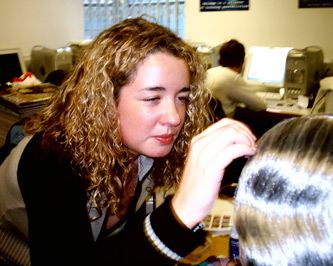 |
Jenny Grogan is putting make-up onto Natalie Marconi face for a movie called "Cry Wolf". The training, work, knowledge and skills of the make-up and costume artists are the same for cinema as for television, but perhaps have more intensity. The demands are greater, from the point of view of the accountant with enormous budget constraints to the increased commitment needed from the staff. Make-up, hair and wardrobe are service departments, their aim being to help create pictures that are pleasing to the eye, or to help create an impression or atmosphere that is correct for the production needs. As a make-up artist it is not unusual to work for six days a week, fourteen hours a day, for six months. Needless to say, this kind of commitment does not help family or social life! (Notting Dale Technology Centre, Room 1), Winter 2003. |
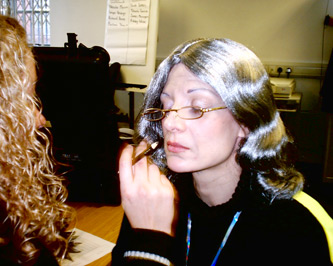 |
It is important for a make-up artist to understand the human skull and bone structure, the formation of the muscles and skin colouring. A make-up, hair or costume designer is employed before the filming starts to do the necessary research, designing, buying and making, and to calculate how many other staff members will be needed. There are many aspects of media work that may require make-up and wardrobe facilities. These include: feature films, video production, film production for television, education and training, advertising, pop promotions and corporate work. (Notting Dale Technology Centre, Room 1), Winter 2003. |
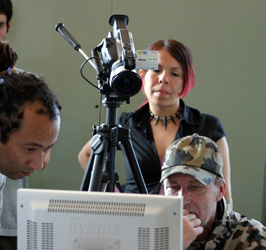 |
Sacha Bowling is with students, (Notting Dale Reception Area). Summer 2003 |
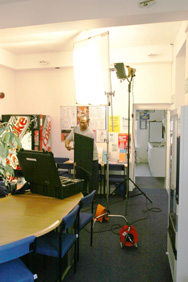 |
Sacha Bowling is setting up lights and flags. There are essentially two main types of "key" light, raw sun and artificial light. The "key" light is the main source used to light the subject, while the "fill" light generally comes from an angle close to the camcorder and is responsible for "filling" and softening some of the shadows caused by the key light. The intensity of the key in proportion to the "fill light" determines the mood of the scene. A "high key" lighting set-up creates a bright scene with a lot of highlights, while a "low key" scene has a much higher ratio of lighting, and creates a much darker and visually more contrasting scene(Notting Dale Reception Area). Summer 2003 |
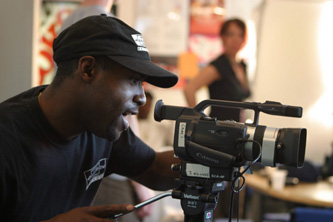 |
Wayne Harrison is the camera operator and he is setting the focus on the camcorder so that the shots look sharp and not soft. Focus is one of the creative aspects of film making. You can use focus to draw the viewer's attention where you want. However, if something important is out of focus, the viewer may feel annoyed or uncomfortable. Generally, when a subject is speaking, he or she should be in focus, unless another subject's reaction is more important. For close shots, a rule of thumb is to focus on the subject's eyes. A picture that is in focus has more contrast than when it is out of focus. (Notting Dale Reception Area). Summer 2003 |
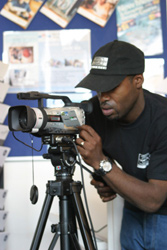 |
Wayne Harrison is framing up the next shot for some cutaways. A cutaway is a shot away from the main action that can be used to cover discontinuities or to condense the action. (Notting Dale Reception Area). Summer 2003 |
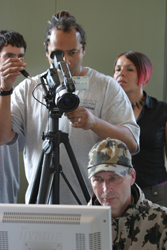 |
Sacha Bowling is on the camcorder and is being watched by his film crew. Crew up in advance, especially the main departments like sound, camera and design. If you don't, you may find yourself on set without a sound recordist. Don't put an amateur at the head of a department like photography or sound. Ask around your industry friends and crew (who are in place) if they know anyone who would work on the film. (Notting Dale Reception Area). Summer 2003 |
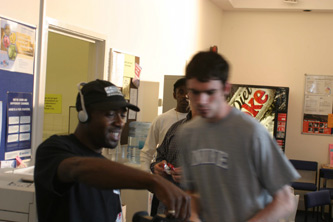 |
Wayne Harrison is showing student Emerson Mayley the perfect framing for the next shot. As a director or producer it is likely that you have less objectivity and more emotional investment in the film than anyone. Often, directors will cling to scenes when they need to go. Listen to other people's comments. (Notting Dale Reception Area). Summer 2003 |
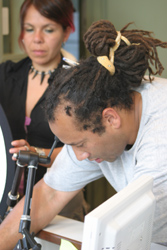 |
Sacha Bowling is setting up the magic arm for the camcorder to be positioned correctly for the next shot, (Notting Dale Reception Area). Summer 2003 |
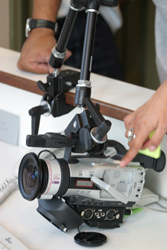 |
Sacha Bowling has set-up the camcorder with an extreme wide angle lens mounted on front of the camcorder. This lens is used when space is limited, for covering as much of the scene as possible. The magic arm is to fix the camcorder into position so that it doesn't move around. (Notting Dale Reception Area). Summer 2003 |
 |
Wayne Harrison is looking at the LCD monitor on the camcorder to make sure that Andre Moses and Nadia Petean are framing up the shot correctly. Shooting on location often means working in confined spaces with each department wanting to see what is taking place. Sometimes it is just not possible for everyone to be on set. If this is the case the assistant director will always call for final checks before any shot. Space can be a major problem as even the biggest of rooms will become sardine like with a full crew. (Frinstead House Tower Block, Freston Road), Spring 2004 |
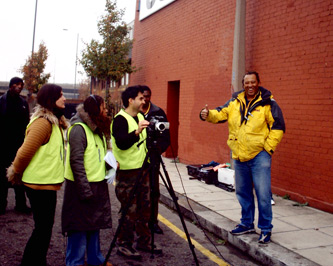 |
The Notting Dale film crew are working together as a team with Sacha Bowling to complete their movie called "White Gold ". Perhaps the most important quality needed to work successfully in the film business is tolerance. Tolerance enables you to work alongside others as part of the team. When filming get's started, standing around chatting can be annoying and does not look very professional. (Bard Road). Winter 2003 |
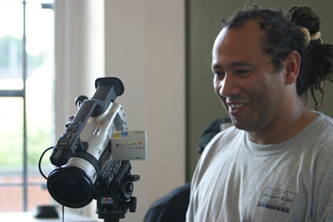 |
Sacha Bowling is having a laugh. (Notting Dale Reception Area). Summer 2003 |
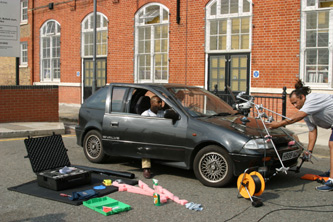 |
Sacha Bowling is working hard on the rig. The ability to work under pressure and to a tight schedule, no matter how prepared each member of the team think he or she is, each is affected by the whole team. A problem in one department may have a knock-on effect on others. You should be able to function individually, anticipating and concentrating, and yet be flexible and work as part of a coordinated team. Each of us strives to do our work to the best of our ability, but this should not be at the expense of others! (Freston Road). Summer 2003 |
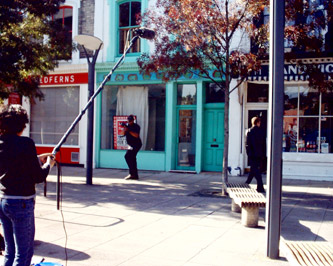 |
Sacha Bowling is using the Steadicam Junior on a students project. Different shot sequences or camcorder movements can create significant meaning. A handheld camcorder shot can create tension, fear and involvement by making the audience feel a part of the action. (Bramley Road). Autumn 2003 |
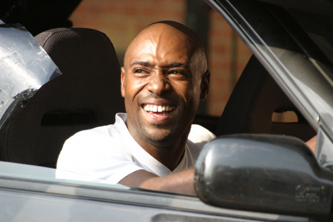 |
Wayne Harrison with a cheeky smile! (Freston Road). Summer 2003 |
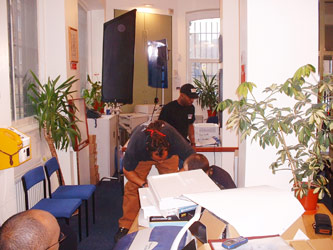 |
Sacha Bowling and Wayne Harrison are setting up lights and flags for the next shot. It used to be the case that large TV studios employed permanent staff and offered sufficient training, but now few of them do and the employment is predominantly freelance. (Notting Dale Reception Area). Winter 2003 |
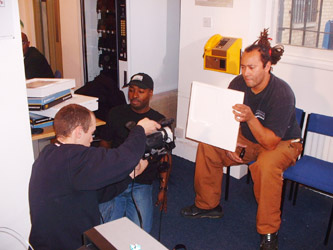 |
Sacha Bowling and Wayne Harrison are helping James Shears set the white balance on the camcorder, (Notting Dale Reception Area). Winter 2003 |
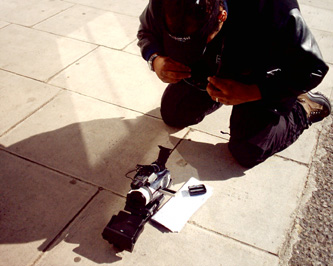 |
Sacha Bowling is getting the Steadicam Junior ready for filming. Film camcorders need to be much more portable than studio camcorders. They are set-up on tripods or various rigging equipment according to the type of shot required. Today a lot of camera work is handheld and there are specially designed camcorders that balance themselves automatically for this type of work. For film production more camera personnel are needed in the department and the training requirements differ. (Freston Road). Autumn 2003 |
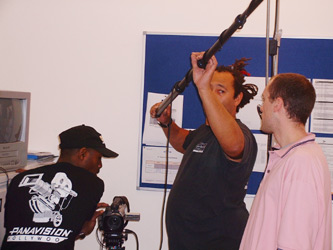 |
Sacha Bowling and Wayne Harrison are setting up the Canon XM2 camcorder and sound equipment for the next shot so that they can record their film in Mini-DV format. One of the most serious drawbacks to tiny DV format is it's inability to record a true SMPTE timecode (Society of Motion Picture and Television Engineers). The numbers you see on the LCD screen move like timecode, but the unfortunate reality is that they're only a relative numeric reference that doesn't transpose. (Notting Dale Office). Summer 2003 |
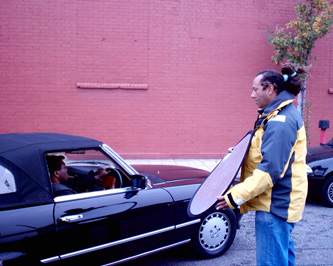 |
Sacha Bowling is using the reflector to bounce the light onto the actors face. (Bard Road). Winter 2003 |
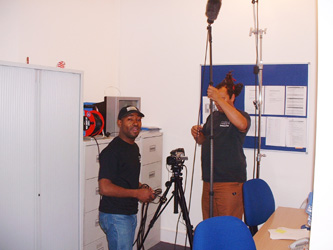 |
Sacha Bowling and Wayne Harrison are setting up the film equipment. Television and film production require many skills in many different departments, but it is necessary for all personnel to share knowledge of general production-making. Various departments have to work very closely together such as camera and sound, for instance, as it is necessary for them to negotiate moves together to prevent sound booms being in the shot. (Notting Dale Office). Summer 2003 |
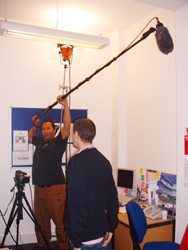 |
Sacha Bowling is showing James Shears how to hold the Boom Pole correctly so that he can capture the sound. When choosing a location, don't forget the sound. There isn't much use shooting a drama film next to an airport (unless you can post sync the dialogue). (Notting Dale Office). Summer 2003 |
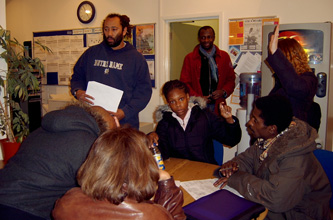 |
The Notting Dale Video Production crew are voting on what scenes they want to direct. (Notting Dale Reception Area), Winter 2004 |
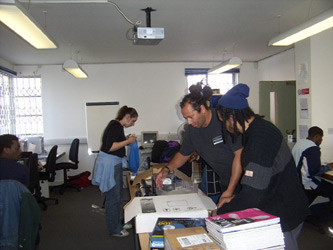 |
Sacha Bowling is in the classroom having a production meeting with student Richard Rhoden (Best Director) and the "Feed The Ducks" team. A production meeting is a chance for all departments to discuss their needs and to help each other if possible. (Notting Dale Technology Centre, Room 1, Winter 2003 |
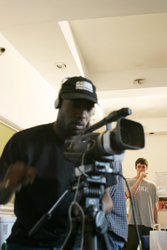 |
Wayne Harrison is enjoying himself as the camera operator. Despite the number of DV camcorders available, the way most of them work is fairly similar. There are some subtle differences. Thankfully, learning to shoot with a DV camcorder is something like learning to drive a car. Once you learn how to use one model, most others will be familiar. But, like learning to drive, DV has it's own manual controls that can help promote your work to a higher level of performance and quality. The camcorders do not require lubrication. You should not use grease anywhere. Try to keep them out of dusty, moist or salt air as much as possible. Use rain covers, plastic bags or garbage bags in these environments. (Notting Dale Reception Area). Summer 2003 |
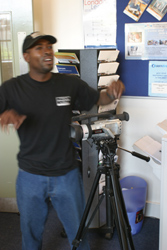 |
Wayne Harrison is talking to students, (Notting Dale Reception Area). Summer 2003 |
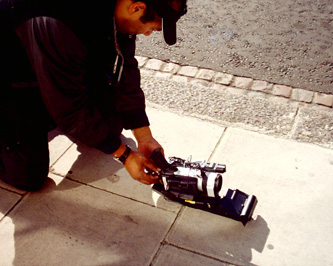 |
Sacha Bowling is positioning the Steadicam Junior on the floor with the camcorder mounted on the top. (Freston Road). Autumn 2003 |
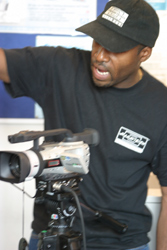 |
Wayne Harrison is one of the directors on a movie called "The Agent" and is giving the actor instructions. Several 'takes' may be necessary before the director is happy with the final outcome. (Notting Dale Reception Area). Summer 2003 |
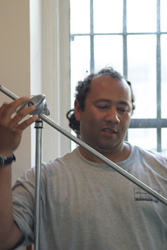 |
Sacha Bowling is setting up a Century Stand to put some flags on the arm to block-out the light, (Notting Dale Reception Area). Summer 2003 |
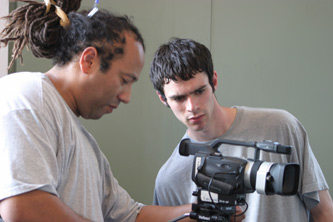 |
Sacha Bowling is showing Emerson Mayley how to frame-up his shot using the LCD monitor, (Notting Dale Reception Area). Summer 2003 |
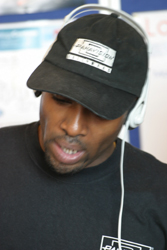 |
Wayne Harrisonis is checking the sound levels on the camcorder to make sure that it is not too high or low but set to roughly -12db. Capturing the right level for sound is very important because it can make or break your movie. Without sound, your missing half of the story! (Notting Dale Reception Area). Summer 2003 |
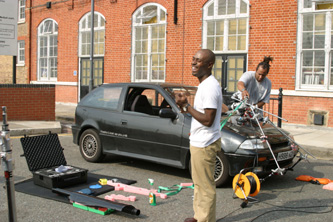 |
Wayne Harrison is having a laugh with the students. (Freston Road). Summer 2003 |
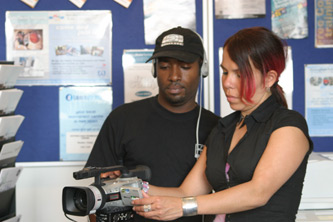 |
Wayne Harrison is checking the framing with student Kary Stewart. Don't fixate on the camcorder, work with the actors and on the story. No one is impressed by flashy shots, they want a movie that engages and moves them. (Notting Dale Reception Area). Summer 2003 |
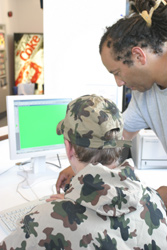 |
Sacha Bowling is giving Peter Wilson instructions on what he must do and he is also dressing the set. Construction builds the sets, set dressing decorates the set with items not handled by an actor, while the props department is responsible for anything that is handled by an actor. (Notting Dale Reception Area). Summer 2003 |
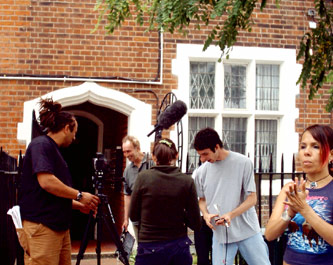 |
Sacha Bowling is on the camcorder filming a movie called "Blind Date which was written and produced by Kary Stewart. A script is divided into a series of scenes. A scene is an event that takes place in one setting in a continuous time period. However, when someone walks from one room to another and the camcorder is moved to a new location, it is often considered two separate scenes in the script. (Freston Road). Summer 2003 |
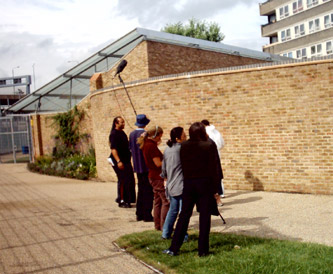 |
Sacha Bowling is the Assistant Director on a movie called "The Portal". Teamwork is most important in each department. There may be a number of people with differing levels of skills and responsibilities. Although everyone will be busy doing his or her own work, it makes for a more successful department if each person is also aware of how help may be given to others. The main benefit in working in television is that the work is mainly short-term contracts, usually daily contracts, sometimes weekly, and only on longer drama productions might a contract be as long as three months. This does allow for a more settled home life and some chance of organising a social life. (Westway). Summer 2003 |
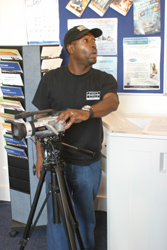 |
Wayne Harrison is looking a little surprised, (Notting Dale Reception Area). Summer 2003 |
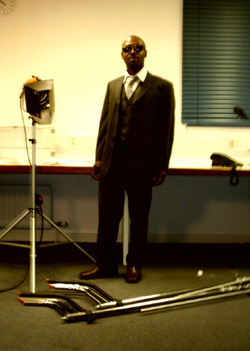 |
Wayne Harrison is doing some acting as the big boss on a movie called "The Agent". Always consider an actor over a non actor, even if the actor in question has little or no experience. They want to be there and will have some training. Unless you are sure of their skills, don't give them any important role. Be aware that they could be spectacularly awful. They may also be unprofessional. There are thousands of actors just waiting for a break! (Notting Dale Technology Centre, Room 2). Summer 2003 |
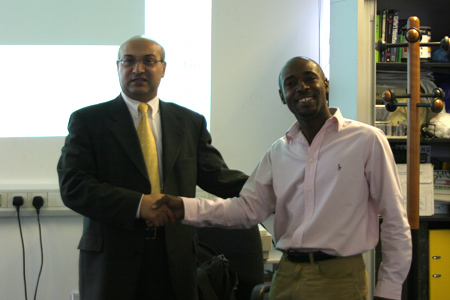 |
Wayne Harrison is being congratulated by Hoss Malek (Managing Director) for his hard work on another successful Video Production Course, (Notting Dale Technology Centre, Room 1). Summer 2003. |